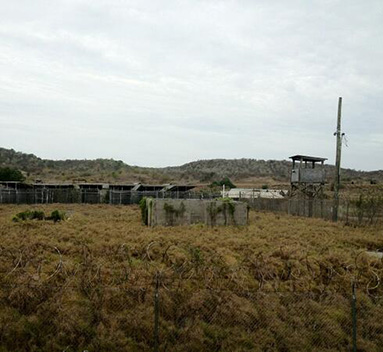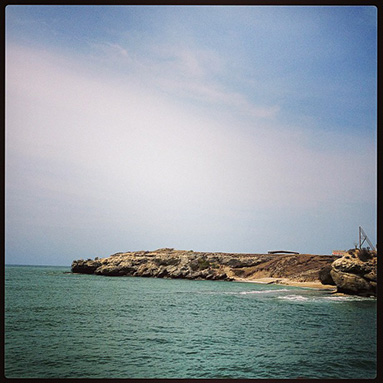A new book of poems about Guantanamo Bay detainees raises the prison's specter of placelessness.
There are few more painful ways to get inside Guantanamo than reading through the mental deterioration and suicide of Adnan Latif, a Yemeni man who—at around 25 years old—was among the first prisoners brought to Guantanamo from Afghanistan in 2002. Latif maintained he had gone to Afghanistan for treatment for a head injury; the government insisted he had gone to train with Al Qaeda. A federal judge ordered him released in 2010, but another court vacated the decision, saying the government record implicating him must be given “a presumption of regularity.” By 2010, Latif’s lawyers were making the case that the government was holding a sick man. Latif sometimes wore a sheet as a cape and did backflips on his cell wall, ate shards of glass, and threw feces and blood at his lawyer and guards. He committed suicide in the fall of 2012 with an overdose of pills he had somehow managed to hoard. After his death, Latif’s body was held in limbo in Germany for months, before finally being returned to his family in Yemen.
I reported on Latif’s death and the circumstances around it, reading all the available documents and speaking to his lawyer. His story affected me as much any tragedy: his suffering was painfully incidental to the Obama administration’s political maneuverings regarding the future of the prison.
770 men have been in Guantanamo since the prison was opened; today there remain 149, some of whose stories are as pathetic as Latif’s, some of whose are more incriminating. Their details – well, some of them – are laid bare in transcripts of the initial “combatant status review tribunals” that the U.S. government granted Guantanamo detainees when the Supreme Court determined, in 2004, that they must have some chance to challenge their detention. And these transcripts have also become fodder for the French poet Frank Smith’s 2010 book Guantanamo, released in July by Les Figues Press in a terse and effective translation by the poet and conceptual artist Vanessa Place.
Smith presents six of these Guantanamo stories, mangling them through a process of repeated questioning. The men are not named in Guantanamo, and the poet does not follow them to their end, as one can with Latif. Instead, Smith works exclusively with the tribunal material (obtained first by the The Associated Press). He arrests the narrative at a moment of judgment, with the detainees responding to their imprisonment in a pseudo-judicial setting for the first time. They are asked to verify or clarify previous statements to explain what brought them to Guantanamo, as though it had been their decision. In response, the prisoners tell the stories of lives spent “wandering from one land to another,/and from the other to a third one again.”
Smith’s mesmerizing book entangles the reader in the unknown men’s fates, and forces us to confront the perverse logic of the prison by enacting it, which makes book as affecting as a read through the raw documents in a case like Latif’s. One poem begins with a detainee saying, “What is this, to witness?” He is asking a technical question of the tribunal, but it strikes out at the reader (rhyming in French -- Qu’est-ce que c’est, témoigner? -- and alliterative in English), who is witnessing at such a distance.
Smith’s book also immerses you in the impersonal rationale that condemned men like Latif in general– in the lethal morass of the terms of our engagement with terrorism, contested terms like “associated,” “ties,” “combatant,” even “battlefield.” As Smith gradually, literally, breaks down these official texts with maddening repetition and distortion, he reveals the linguistic muddle, the mutual incomprehension, and the actual mystery around these men about whom we, in some way, ought to know everything.
Smith makes stubborn use of the French pronoun on, which Place variously translates as “we,” “they,” “it is said,” and with a third person singular verb, leaving out the speaker entirely: “Asks if went from Kazakhstan to Kabul, Afghanistan, in September, 2000. Answers that’s it, that’s right.” Elsewhere, the back-and-forth is punctuated with question-and-answer headings, or simple conversational dashes. It’s effectively disorienting, achieving none of the impersonal clarity toward which such a system strives. What Place loses without the concise ambiguity of on is closer to the bureaucratic thicket through which the government and these men assert their versions of the story. It also fits the inversion of interrogation on display. We all know about the torture that marked some prisoners’ early days at Guantanamo, which officials said was necessary to extract information. Now, the interrogator asks perversely, “are there other facts that would help us understand why you are held here?”

The pronoun confusion is brutally broken when the characters speak in long plaintive or ranting first person narratives. Sometimes, Smith intercedes, breaking into more traditional poetic diction:
Then, by boat,
when it stopped working, by helicopter,
they crossed the Amu River
the two hundred Uzbek families,
as well as the man, his wife, and his mother.
and
The man has no business here.
I have no business here,
he says.
Smith exploits trivial pieces of evidence and cultural ignorance in the questioning. A vegetable garden. A Casio watch. Much discussion of passports. Why would someone go to Afghanistan of their own accord? “Question: You talked about the call of Allah, what is this?” “But we don’t know the months in Arabic.”
Despite the exhaustive documentation of their cases, the men’s stories are unbelievably alien. Even for a sympathetic ear, their lives warrant a novel’s worth of explication. Instead, fragments of their lives are served up conflated and piecemeal: the everyman of Guantanamo, the ontological state of confusion embodied by the place.
***
Guantanamo – the prison and the place – is only rarely mentioned in the detainee accounts. When it is spoken of, it is usually referred to as “Cuba,” so the titling of the book Guantanamo is almost incidental.
Yet the book depends on the signal force of that name and the specter of placelessness it signifies. The U.S. seized control of the Bay during the Spanish-American war, and has leased the land from Cuba since 1903 (though Fidel Castro won’t cash our rent checks.) For the purposes of the war on terror, the government tried to designate Guantanamo extraterritorial, out of reach of the U.S. legal system. The Supreme Court disagreed, in 2008. It is foreign, the Court ruled, but it’s under complete American control.
I went to the military base in 2013 to cover hearings in a military commission trial. I had applied for a spot, signed a Memorandum of Understanding giving public affairs escorts control over much of my activity, and shown up at dawn at Andrews Air Force base in Maryland to board a plane chartered by the military along with a handful of other reporters, lawyers, and commission staff. We flew in over fences demarcating Cuba. Just off the tarmac, our names were checked against a manifest. But on the way back, the stewardess distributed customs and immigration arrival cards for us to fill out. I stared at the blank on the form asking me what countries I had visited. I asked the woman next to me, who worked for the Navy, what we were supposed to write. She shrugged and printed “GTMO”. I followed suit.

I stayed in Camp Justice, the rows of Quonset-hut-style tents where reporters are stashed. It’s next to the Expeditionary Legal Complex, which houses the military commissions. The court and the prison camp are the domain of the Joint Task Force Guantanamo, and kept at a distance from the sleepier Naval base. Most of the service workers on island are not American; in the Subway, in trucks emblazoned with contractors’ logos, we see workers from the Philippines. Jamaicans serve up barbeque from a roadside shack. On the way to Camp Justice there’s a shrine to the Our Lady of Cobre, the patron saint of Cuba, and then a little monument with a woman painted all the same brown as her army uniform with garish red lips and cheeks and she’s unfurling an American flag and an eagle is alighting on it. The vegetation is scraggly and brown, dotted with drab buildings and mysterious rusting equipment and bunkers. Military bases often seem provisional, but this occupation, despite being 100 years old, feels particularly impermanent.
Smith is attuned to that geographic ambiguity in the detainees’ predicament. Many of them were stateless by circumstance even before by the Americans made them so, and now they are citizens of this no-place. Near the end of the book, a detainee asks to go to the United States. “This is what I wish for most in the world,” he tells his American captors.
If Smith plays up the ironies of the men’s detention, the Bay echoes that duplicitous language in spades. It’s full of ironic factoids. “Prisoner” expresses the blunt truth of the men’s condition, but the government’s preferred term, detainee, is technically accurate. “Recidivism” is hard to measure when there’s the possibility that men did not return to terrorism but turned to it only after imprisonment. There’s a street named for José Martí, the hero of Cuba’s independence from Spain. The gift shop sells beach towels that say “It doesn’t GITMO better than this”; a pen-knife that says “proud American”; and Gitmo Christmas ornaments. The military says hunger strikers submit to being force-fed, and therefore, aren’t fasting. The government has argued that detainees own accounts of their torture and imprisonment by the CIA can be classified. There’s a red box spray-painted on the ground designating the corner where reporters can take pictures. There’s a sign saying “no photography,” which is great to photograph.
Reading Guantanamo, I think of our compete isolation from the men we were there to cover. In hours of dead time between hearings, we tried to sidestep the other journalists (a group of reporters with no subjects is a circular firing squad) as we quickly exhausted the stories of our kind public affairs escorts, who had to sit sober when they took us to dinner at the Irish pub O’Kelly’s.
The human rights observers bent our ears; the government prosecution gave us reasoned arguments in infuriatingly inhuman(e) language. We were not allowed to visit the prison – only Camp X-Ray, where arriving detainees were corralled in 2002, in open-air, chain-link enclosures watched by rickety wooden guard towers. We visited what our escorts said were interrogation rooms, in a row of plywood sheds with holes where air conditioners once sat.
A dead deer, a spiker with fuzzy horns, lay on the ground on the path in front of them. Some were bare except for animal droppings, while others had benches, wooden tables and stools of basic plywood. In the last room, a stack of twenty-odd cane chairs with cushions and curlicue backs. The rooms, like the cages, were overrun with vines and volunteer trees. Butterflies and lizards darted through them. They are being kept somewhat intact supposedly for future court evidence but most likely also because they serve as a visual separation from the new and humane Guantanamo the military would like to present.

I filled those vacant hours by cataloguing details made weighty by what “Guantanamo” stands for, in the way Smith uses it as the perfect metonym for the persistent uncertainties of the war on terror. Fewer than two hundred men foiled President Obama’s ambition, but that was only ever to close Guantanamo the place, not necessarily the legal rationale beneath it.
It’s easy to end in irony. Few people can resist citing Kafka in describing Guantanamo, and the poet’s duty to obfuscate is almost too easy. Smith and Place have both emphasized the manipulation of found text as commentary on the instability of the originals: “unclassified verbal evidence” discussed with detainees through an interpreter. Smith translated the English documents to French, and Place put them back into English without consulting the originals. That text was only the beginning. The men in Guantanamo provided information to a shifting legal and political spectrum, to interrogators of different stripes and to military commissions, which were revamped, shut down, reopened. Initial convictions are now being invalidated. Trials are still mired in basic procedural questions. Many of the men cannot be tried, but the government maintains they cannot be safely released.
Smith uses the irony to tell the stories flat, and that is why these poems, though sincere, are not sentimental, nor do they read like an Amnesty International press release. In this framework, Smith and Place say, there’s no place for truth, and without it, no hope for justice. Twelve years on, though, we do have stories.
